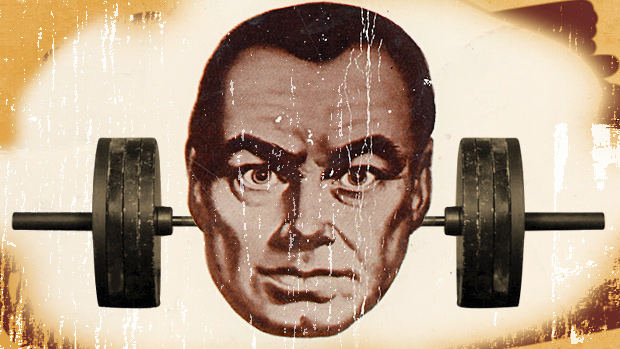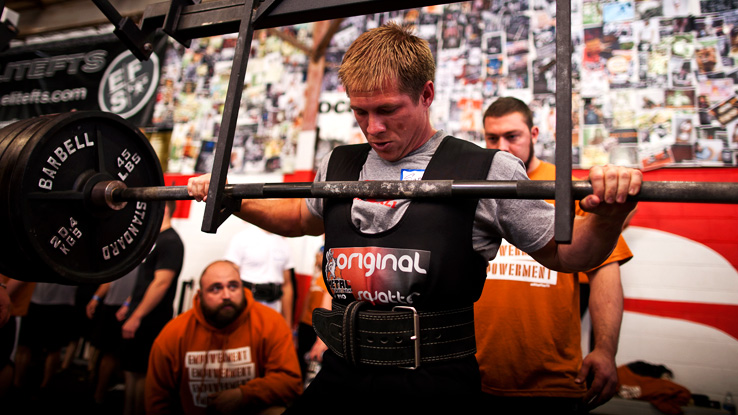Hyperactive Hypertrophy
Tattoo this on your forehead: training variation is very important for maximal, sustained muscle mass gains. It can be achieved directly by changing the adaptive stress your muscles must handle. Indirectly, training variation increases your level of motivation in the gym. In other words, it's "fun" in a challenging, excruciatingly painful kinda way.
In the first two parts of this series, I focused on alternative exercise selection to spark new muscle growth. In this third installment, I'll present a few High Stimulation Training Methods (HSTM's) that can drastically accelerate your rate of muscle growth.
For bodybuilders, competitive or recreational, increasing muscle mass is a primary objective and probably the most important goal of all. Strength athletes can also benefit from growing larger muscles as it'll result in strength gains in the long run; that is, once they "learn" to utilize their new muscle tissue efficiently.
The average person who trains only for looks and health can also benefit from the increased muscle mass as it'll improve how good he or she looks and can even help prevent some injuries. Even endurance athletes can benefit from a little hypertrophy work.
As you can see, increasing muscle size is a common goal to almost everyone who trains – or at least it should be. Of course, the relative importance of hypertrophy compared to other capacities/qualities will differ from one individual to the next, but everybody who trains wants to increase their muscle mass to some extent at some time in their training career.
This article will explore some interesting methods to induce maximal hypertrophy. You'll notice that some of the methods I'll describe have already been used by bodybuilders and athletes everywhere. In strength training, nothing is 100% new; everything has pretty much been done at some point or another. However, the methods presented in this article are the most effective ways to induce muscle growth, both from a scientific and empirical standpoint. Get ready to embrace the pain!
High Stimulation Training Methods (HSTM's)
What exactly is a high stimulation training method? Basically it refers to a specific way of executing an exercise to maximize the adaptive stress placed on the muscle fibers. What we're looking for with HSTM's is the complete stimulation of as many muscle fibers as possible within the muscle group being trained.
Professor Vladimir Zatsiorsky explained in his excellent textbook, Science and Practice of Strength Training, that to be stimulated into growing, a muscle fiber must not only be recruited, but also exhausted. (Zatsiorsky, 1996)
He also noted that, "Motor units that are recruited but not fatigued are not trained. Only motor units which are recruited and exhausted are subject to training stimulus in this set." (Zatsiorky, 1992)
The above illustrate that the more motor units/muscle fibers you can thoroughly exhaust during a set, the greater the adaptive stress and the greater the potential growth.
This means that for maximum hypertrophy stimulation, you should go to positive muscle failure and even beyond. This is the only way of ensuring maximum muscle fiber exhaustion. The limitation with this approach is that the closer you go to muscle failure (or even go beyond it) the more stressful the set is to both your muscles and nervous system.
Is that to say that we should not go to failure, or that we should avoid the extreme training methods I'm about to present? No! It means that the careful rotation between sets performed to failure, to beyond failure, and short of failure, is a must to allow for maximum long-term progression.
Note: Individuals who are only seeking functional hypertrophy don't have to train to failure. The fast twitch muscle fibers are easily fatigued during a set, even if it's not conducted to positive failure. For these individuals, stopping one or two sets short of failure might be a better option.
However, if maximum total hypertrophy is what you're looking for, then periodically training to failure and beyond is a necessity!
The Methods for Mass
I'll present quite a few new training methods below, so you better be ready! I'll describe two types of methods: total hypertrophy methods and functional hypertrophy methods. By total hypertrophy, I mean simply increasing muscle mass as much as possible without regard to gains in strength, relative strength, and power. Functional hypertrophy, on the other hand, refers to gains in muscle mass that lead to a proportional improvement in strength and/or power.
Total Hypertrophy Methods
1. Tempo Contrast
This method is fairly simple: you alternate between superslow reps and superfast reps within the same set. My classic template is to use a 604/explosive contrast, meaning that the slow reps are performed with a 604 tempo (6 seconds eccentric, no pause, 4 seconds concentric) while the fast reps are done as fast as possible.
Normally, eight reps are performed using this method, with the tempo changing every two reps:
- Rep 1: 604
- Rep 2: 604
- Rep 3: explosive
- Rep 4: explosive
- Rep 5: 604
- Rep 6: 604
- Rep 7: explosive
- Rep 8: explosive
This method is very effective at stimulating as many motor units as possible and thus can provide for a very important growth stimulus. When using this method, three to four sets are performed for each exercise.
2. Advanced Tempo Contrast
This second torture is a spin-off of the first one. We want to increase the level of difficulty to provide for an even more powerful growth stimulus. We're going to perform a regular contrast set, but after the last rep we're going to hold the weight (isometric action) at the mid-range point of the movement until we can no longer hold it in place. A set would look like this:
- Rep 1: 604
- Rep 2: 604
- Rep 3: explosive
- Rep 4: explosive
- Rep 5: 604
- Rep 6: 604
- Rep 7: explosive
- Rep 8: explosive
- Rep 9: Hold mid-range point for as long as possible
This method is the gym version of medieval torture! But it's worth the pain as the isometric hold will ensure that every single motor unit in your muscle is thoroughly stimulated. Because of the high stress factor of this method, only one or two sets need be performed.
3. Dynamic/Isometric Contrast
This is another simple, yet painful method. You're going to hold an isometric pause at the mid-range point of the movement on each rep. The length of the pause will vary from rep to rep to accommodate the growing level of fatigue:
- Rep 1: 10-second pause
- Rep 2: 7-second pause
- Rep 3: 5-second pause
- Rep 4: 3-second pause
- Rep 5: 1-second pause
- Rep 6: No pause
Once again, this method (especially the isometric component) will help you recruit and stimulate more motor units, mostly because you can recruit up to 10% more motor units during an isometric action than during a dynamic action.
This method is especially effective for isolation exercises while the tempo contrast might be best suited to compound exercises. When using this method, three to four sets can be used.
4. Advanced Dynamic/Isometric Contrast
For those who like pain, this method will quickly become one of your favorites! It's similar to the preceding one with a small addition: after the sixth rep you reduce the load by 20 to 30% and perform as many reps as you can. If that doesn't get you growing, nothing will!
A set would look like this:
- Rep 1: 10-second pause
- Rep 2: 7-second pause
- Rep 3: 5-second pause
- Rep 4: 3-second pause
- Rep 5: 1-second pause
- Rep 6: No pause
Reduce weight by 20-30% and perform as many regular reps as you can.
This method is extreme and can be stressful on the CNS (central nervous system). Since we want to minimize CNS stress to avoid neural-based overtraining, only one or two sets need be performed.
5. Extreme Drop Set
This method is truly insane! It's based on the "Beyond Failure" system created by the late and great Trevor Smith (a 400 pound monster powerbuilder). It's a truly hardcore method and very few individuals can actually handle it without suffering serious psychological trauma! Sounds fun, huh?
You start with a load you can lift 8 to 12 times in good form. Perform as many reps as you can with this load. When you can no longer complete a rep, your partner helps you complete 3 to 6 more reps. Once this is done, you immediately strip 20-30% of the weight and continue to perform reps until failure. When you reach that point, your partner once again assists you in completing 3 to 6 more reps. You then remove yet another 30-40% and perform reps until you can't move anymore!
This one is only for the truly mentally unstable. I tried it and it works, big time! However, because of the super high stress of this method I recommend using it only for one set of one exercise per body part if you use a compound movement, or two sets if you use an isolation movement (you can still perform a few regular sets of another exercise for the same muscle group).
Some will be able to handle two sets, but in most cases it'll be unnecessary and counterproductive (excessive CNS stress). When using this method, I'll go against what I recommend 99% of the time and recommend machines (except, of course, when using compound movements). This is for safety and convenience purposes. While this method can be used with free weights, it can become dangerous late in the set, especially if your training partner is having a rough morning!
6. Extreme Drop Set, Version 2
This second method is for those who don't have a good training partner and thus can't perform the regular extreme drop set. The basic principle is the same, but instead of doing 3 to 6 assisted reps, you're going to use the rest-pause method.
When you complete your 8 to 12 reps, instead of having a training partner assist you in completing 3 to 6 more reps, you'll rest for 10 seconds and resume the set, trying to complete as many reps as you can. Then you drop the weight by 30 to 40% and perform reps until failure. You then take 10 seconds of rest and try to complete a few more reps. Reduce the weight by another 30 to 40% and perform reps until failure again. After that perform one set of retching and gagging.
Just as you did with the regular extreme drop sets, only perform one or two sets of one exercise per muscle group to avoid overloading the CNS.
7. Post-Fatigue Method
The post-fatigue method consists of adding a less complex movement (an isolation exercise) after your main movement (a compound exercise) to fully stimulate and fatigue the targeted muscle group. These two exercises are done with no pause in between them.
The logic behind this method is that in complex (multi-joint) movements, the weaker muscle groups will always fail first, leaving the prime movers under-stimulated. For example, in the bench press the triceps or deltoids are likely to fail before the stronger pectorals, thus leaving the pectorals under-stimulated.
By adding an isolation exercise for the pectorals (like flyes) right after your set of bench presses, you'll be able to fully fatigue and stimulate your pecs. The more stimulation you put on your muscles, the more protein degradation occurs, and the higher the anabolic response.
When using this method, the number of reps can vary a lot. Use anywhere from 5 to 15 reps For the first exercise of the superset (the compound movement), depending on your objective. Use slightly higher reps for the second exercise (the isolation movement); 10 to 20 reps is adequate.
While you could perform as many as five sets of such a superset, only two to three sets should be used most of the time in order to preserve the CNS.
8. Pre-Fatigue Method
The objective of this method is somewhat similar to the post-fatigue method in that the goal is to fatigue a specific muscle group that might not get fully stimulated from a complex exercise.
As I've mentioned, the strongest muscle involved in a movement will rarely be fully stimulated because the weaker muscles will fail first. However, if you fatigue this muscle before you perform the main exercise, then you'll be able to fully stimulate it when you do the main exercise. For example, perform flyes before you do a barbell bench press.
This technique is very effective at stimulating hypertrophy in a specific body part (the body part for which you do the isolation exercise). However, it isn't as good for developing overall hypertrophy as the post-fatigue method because it's possible that you won't be able to use as much weight on the main exercise due to the pre-fatigue set.
Because of this characteristic, the main use of this method is to improve a weak body part. If you have an underdeveloped chest compared to your shoulders and arms, use a pre-fatigue set for the chest. If your back is lagging behind your arms and shoulders, use a pre-fatigue set for the back. The variables (sets and reps) are similar to the post-fatigue method.
9. Pre- and Post-Fatigue Method
This is certainly the most difficult hypertrophy method of all, and probably the most effective as well. It's simply a mix of the pre-fatigue method and post-fatigue method.
This leads to the greatest possible hypertrophy response of all the methods you can use in the gym (except maybe for the extreme drop-set). Because this method is so intense, it should be used sparingly. I suggest using it only for one muscle group per cycle to save the CNS from gross over-stress.
You can do two types of pre/post-fatigue training:
- Targeting the same muscle group during the pre-fatigue exercise and the post-fatigue exercise. This will place a large hypertrophy stimulus on the targeted muscle group.
- Targeting one muscle group during the pre-fatigue exercise and another one during the post-fatigue exercise. This allows you to correct two different weaknesses at the same time.
The number of reps can vary from 5 to 15 for the compound exercise and from 10 to 20 for both isolation exercises. Due to the higher stress level of this method, only one or two sets should be performed.
Functional Hypertrophy Methods
10. Medium Rep Cluster Sets
A cluster is just a fancy name for the old rest-pause method. It means you perform a prescribed number of reps, then take a very short break (10 to 20 seconds) and resume the set. The short break allows for a slight ATP-CP regeneration and CNS relief that enable you to perform a bit more work with the same training load.
When using medium rep cluster sets I generally recommend performing two pauses during a set (thus performing three sets of reps within a set ... if that makes any sense!).
Here's an example:
- Perform 5 reps (1-2 short of failure)
- Rest for 10 seconds
- Perform reps to failure
- Rest 10 seconds
- Again perform reps to failure
When training for functional hypertrophy I suggest aiming for sets of 8 to 10 total reps (for example: 5 reps, rest, 3 reps, rest, 2 reps). For most people that means using a weight they can normally handle for 5 to 6 reps.
11. The Pure Cluster Set
The pure cluster set is what the original application of the method was supposed to be: a series of single reps with a load that's 90-95% of your maximum with a 10 to 20 second pause between singles.
The great advantage of this technique is that it's auto-regulatory: you automatically induce just the right stress to your body by doing singles until you fail. You should aim for 8-10 singles with a 10-20 second pause. Once you can hit that mark, increase the load for the next workout.
This is one of my favourite methods to build up a lot of functional hypertrophy as well as strength. An added benefit is the improvement in recovery capacity from maximal effort work, which can be of tremendous importance for many types of athletes.
12. Manual Eccentric Overload Set
The eccentric portion of a lift (lowering the weight under control) is what builds the most muscle mass. So we want to emphasize this eccentric portion as much as possible to stimulate maximum gains. One very simple way of doing this requires nothing but a training partner. It's the "poor man's" variation of using weight releasers.
You perform a regular exercise, but during the eccentric/lowering portion of the lift, your partner increases the amount of resistance by pushing or pulling against you while you resist his efforts. For example, in the bench press, during the lowering portion your partner would push the bar down to increase the amount of resistance. Once the bar reaches the chest he would remove his hands to allow the lifter to complete the rep.
Just how much pressure does one have to apply? Add as much manual resistance as possible as long as the lifter can execute the eccentric portion in five seconds. If he can't control the load for five seconds, you're pushing too hard. Bar weight should be around 70-80% of max. Sets of 5-6 reps are best when using this method.
Now, weight releasers are probably my favourite training tool. However, this method has two important advantages over using releasers:
- You can adjust the amount of extra resistance as the set progresses (depending on fatigue level).
- You can perform multiple-rep sets. With the releasers, all you can hope for is cluster sets because you have to reload the bar with each new rep.
The obvious disadvantages are that it's hard to quantify exactly how much extra resistance your partner is applying, and it requires a capable training partner, not just any numbskull who happens to walk by.
13. Manual Concentric Overload Set
This is the exact opposite of the preceding method: your partner pushes down on the bar not when you're lowering it but when you're trying to lift it.
The amount of extra resistance should be just high enough to make the repetition challenging, but not impossible. Ideally we want to shoot for a 3 second concentric/lifting portion. The lifter should not try to lift the bar slowly; he should push as hard as he can.
During the eccentric/lowering portion of the lift, your partner releases the bar, thus reducing the load. This type of training is very useful to stimulate concentric strength gains, which is important in many sports. Furthermore, by removing the eccentric emphasis you reduce the amount of muscle damage inflicted on the muscles. While eccentric emphasis is best to stimulate maximum size gains, always emphasising the eccentric portion of a lift is asking for trouble (in the form of acute or chronic overtraining).
I recommend using a bar load of 70-80%, adding resistance during the concentric portion so that you can't perform more than 5 to 6 reps. This technique is very effective for gaining relative strength (amount of strength in relation to body weight) as it'll increase strength more than size. For athletes involved in weight class sports, this can be very useful.
14. Heavy Partials
When used correctly, performing heavy partial reps can be quite useful at stimulating extra muscle growth and strength gains. It's a method that shouldn't be abused though, and it certainly shouldn't replace full range of motion exercises.
However, once in a while, performing heavy half-reps in movements such as the bench press (from elbows 90 degrees to lockout) and deadlift (from knees to lockout) can spark up new gains. This occurs because of the super high tension involved in those lifts.
When performing partials I suggest you use them right after your sets of a similar full range of motion exercise. For example, do your deadlift sets and when you're done perform one to two sets of heavy partial deadlifts. Other people like to start with the partials then move on to the full range of motion exercises, but I find that the first option is safer as it gives you more time to warm-up properly before attempting super heavy work.
I'd recommend sticking with the same number of reps as you used for the full range of motion exercise. For example, if your program calls for 5 x 5 on the deadlift, you'd perform an additional one or two sets of 5 reps in the partial deadlift.
Make sure to increase the load by around 20-30% on the partials.
Wrap Up
This concludes the third part of the "Violent Variation" series. By now your training arsenal should be full of new ways to inflict pain upon yourself and grow like never before.
The methods described in this article are very powerful, but if performed in excess they'll lead to stagnation and even overtraining, so don't use them all the time. Rotate between them frequently, keep the total volume low and you'll grow!





